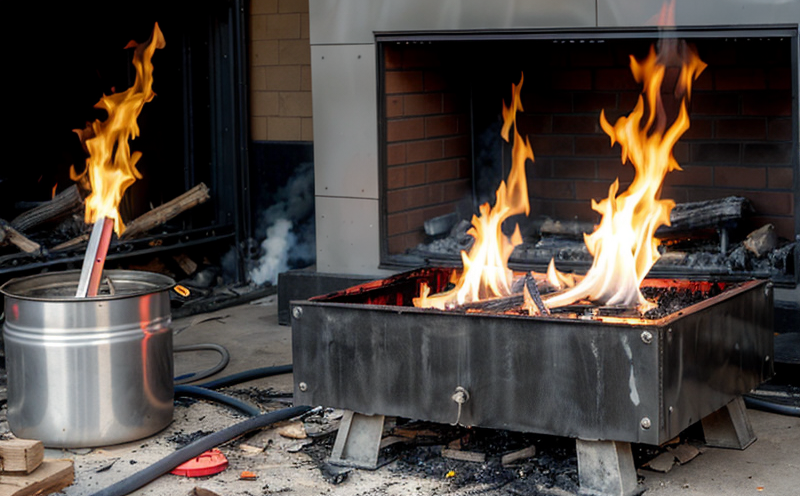EN 50265 Vertical Flame Test for Insulating Materials
The EN 50265 standard is a widely recognized method for evaluating the fire performance of insulating materials used in various electrical and electronic devices. This test assesses how a material behaves when subjected to an ignition source, specifically focusing on its flame propagation characteristics. The primary goal of this testing procedure is to ensure that the materials meet regulatory requirements and industry standards, thereby enhancing safety during use.
During the vertical flame test, specimens are exposed to a specific heat flux for a defined period under controlled environmental conditions. This ensures consistency across different laboratories performing the test. The standard specifies detailed procedures including specimen preparation, apparatus setup, and precise measurement of parameters such as the length of the flame propagation, the time it takes for the flame to extinguish, and the extent of material damage.
The EN 50265 vertical flame test is particularly relevant in sectors where electrical insulation materials are used, including automotive electronics, consumer appliances, and industrial machinery. Compliance with this standard helps manufacturers meet international regulations designed to protect end-users from potential fire hazards associated with faulty or inadequately tested insulating materials.
The testing process begins by preparing the specimen according to specified dimensions and weight requirements outlined in the standard. Specimens are then mounted vertically on a holder inside a specially designed chamber equipped with an ignition source that delivers controlled heat flux. Once ignited, the flame is allowed to propagate along the material for a set duration before being extinguished automatically.
Throughout the test, critical measurements such as peak flame height and after-flame time are recorded using high-precision instruments. These metrics provide valuable insights into the flammability properties of the tested insulating materials, helping engineers make informed decisions about their selection and implementation in product designs.
The results from these tests play a crucial role in ensuring that electronic components comply with relevant safety standards and guidelines. By adhering to EN 50265 specifications, manufacturers can demonstrate adherence to global best practices for electrical insulation materials, fostering trust among consumers and stakeholders alike.
For quality managers responsible for overseeing production processes, this test offers a robust framework for validating material performance consistently across batches. Compliance officers will find it useful in ensuring that products meet legal requirements before being brought to market. R&D engineers can leverage the insights gained from conducting these tests to innovate safer materials and improve overall product reliability.
| Key Parameters Measured | Description |
|---|---|
| Flame propagation speed | The rate at which the flame spreads along the specimen. |
| Peak flame height | The maximum vertical dimension reached by the flame during testing. |
| After-flame time | The duration after ignition until complete extinguishment of the flame. |
Applied Standards
EN 50265 is part of a broader family of standards aimed at ensuring the safety and reliability of electrical equipment. It specifies the procedures for conducting vertical flame tests on insulating materials intended for use in electronic devices exposed to high temperatures or potential ignition sources.
The standard covers various types of insulating materials commonly employed in the manufacturing of components like printed circuit boards, connectors, and other assemblies subjected to rigorous operating conditions. By adhering to EN 50265 requirements, manufacturers can ensure that their products meet stringent safety standards set forth by international organizations such as IEC (International Electrotechnical Commission) and CE marking directives.
It is important to note that while EN 50265 focuses primarily on insulating materials, its principles may also apply indirectly to other materials used in electrical applications where fire resistance is a critical concern. The applicability extends beyond mere compliance; it promotes the development of safer products capable of withstanding harsh environments without posing undue risks.
Quality and Reliability Assurance
The importance of quality assurance cannot be overstated when dealing with electrical insulation materials due to their critical role in protecting sensitive electronic circuits from damage caused by overheating or accidental ignition. Ensuring that these components adhere strictly to EN 50265 guidelines provides peace of mind for all parties involved—manufacturers, suppliers, and end-users alike.
Quality assurance teams play a pivotal role in implementing stringent quality control measures throughout the manufacturing process. By integrating rigorous testing procedures such as those specified in EN 50265 into their workflows, companies can identify any issues early on and address them promptly before they affect broader production runs or customer satisfaction levels.
Compliance officers must stay abreast of evolving regulatory requirements related to fire safety standards to ensure that their organizations remain compliant with relevant directives. This includes staying updated on changes made by governing bodies like IEC, ISO, and national standards organizations regarding the classification and testing methodologies applicable to electrical insulation materials.
R&D engineers benefit significantly from incorporating EN 50265-compliant tests into their product development cycles. By leveraging this standard early in the design phase, they can refine material choices based on real-world performance data rather than relying solely on theoretical models or assumptions about how a particular substance might behave under extreme conditions.
Supplier management practices also become more effective when suppliers are required to provide certification indicating their adherence to EN 50265 standards. This ensures that every component used within the supply chain meets established criteria for fire resistance and safety, reducing the risk of introducing non-compliant parts into final assemblies.
Competitive Advantage and Market Impact
- Maintains market leadership by ensuring consistent product quality across all regions.
- Safeguards brand reputation through adherence to strict safety standards.
- Attracts discerning customers who prioritize product safety and reliability.
- Promotes long-term relationships with regulatory bodies and industry partners.
- Aids in securing new business opportunities by demonstrating commitment to best practices.
By implementing EN 50265-compliant testing into their operations, businesses not only enhance the safety of their products but also position themselves favorably within competitive markets. This approach fosters trust among consumers and strengthens partnerships with key stakeholders, ultimately driving sustained growth and success in the industry.





